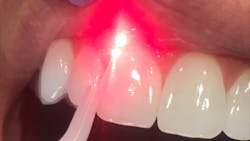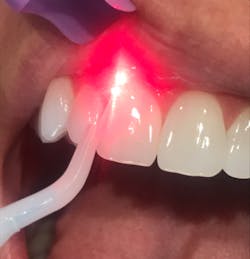It is an exciting time to be a laser hygienist. We continue to find more procedures that we can use the laser for in our clinical world. Let’s look at laser-assisted periodontal therapy (LAPT) and laser bacterial reduction (LBR). LAPT uses the laser in the depths of the pockets to decontaminate diseased periodontal pockets. LBR is used more as a “preprocedural rinse” around every tooth. This procedure can reduce bacteria and be used on periodontal patients as well as those who are scheduled for a prophy.
LAPT: What it is and how it’s done
LAPT is the procedure we do right after we complete SRP—or “periodontal therapy” as I prefer to call it. In our office, the laser is used on every periodontal patient when we do periodontal therapy. We don’t give patients an option to choose “with or without a laser,” because we know that the procedure without the laser wouldn’t benefit the patient. Lasers offer the best results (and it’s our office policy).
You may also be interested in:
So, you want to be a laser dental hygienist?
Which dental laser should I choose, and what can I use it for?
What type of training do dental hygienists need to use lasers?
The protocol with LAPT is to completely clean the surfaces of the tooth structure with ultrasonics and hand instrumentation, and then immediately utilize the laser into the depths of the diseased pockets. This shows how important full periodontal charting is for every patient.
Considerations
With the proper training, you’ll be able to determine what settings to use for your laser procedures, depending on the tissue absorption and correct chromophore. You can’t just use the presets that come with lasers and think that’s all that you need. You’ll need to take all these things into consideration and apply the setting and time for each pocket. It is extremely important that you not use incorrect settings. Being careful in your selections will prevent you from potentially cutting tissue and working outside the scope of practice for a hygienist or using a power that’s too low and not using the laser to do the task you were trying to accomplish. The most important thing is to always read the tissue.
Many times, the hygiene department begins with using a diode laser. A good starting point is 0.5 watts of power, which allows you to turn the laser up if there’s no tissue interaction or turn it down if it’s too much energy for the procedure.
Take the speed of movement into consideration. The laser is not like an ultrasonic; lasers are not to be used at that speed. To interact with the tissue, place the laser beam so it points at the tissue—not at the tooth. Since the laser beam is invisible, it’s essential to keep the red aiming beam on; it’s like a pointer giving small thermal energy to the area, with the invisible beam of the laser doing the decontamination.
It’s not necessary to always “see” diseased tissue being removed. Sometimes there’s just a high rate of bacteria that we can help reduce, allowing healing to begin. Move the laser up and down in vertical strokes, as well as side to side in horizontal strokes. This way you create a cross-hatching technique that ensures you completely decontaminate the diseased periodontal wall to allow new tissue attachment.
Once this procedure is completed, place vitamin E on the tissue to allow rehydration and soothe the lased area.
Typical protocol from this point is to see the patient again in six weeks as a six-week therapy (not a six-week check that devalues the reason for the appointment) and complete a periodontal charting to determine the success of treatment. At that time, you can decide when to see the patient for return visits—typically no longer than three-month periodontal maintenance appointments as the areas of concern heal and then lasing as needed for each subsequent appointment. Once the area has healed and the pocket depths have been reduced, you can start moving the periodontal maintenance appointment to appropriate intervals and adjust as needed. This is known as individualized care.
LBR: What it is and how it’s done
LBR is to be used as a preprocedural rinse and can be done at every hygiene appointment at the beginning or end of the appointment, or in some cases at both times. With LBR, set the laser at a very low setting, typically 0.3–0.4 watts. You’ll still point the laser at the tissue, but no tissue interaction takes place at this setting. The aim of this procedure is to reduce the overall bacteria count to prevent the spread of disease. LBR can often be used to prevent future problems in your patients’ dental health.
There are several laser procedures that dental hygienists can do, depending requirements in each state. LAPT and LBR are two of the most common laser procedures, but sometimes their differences can be confusing. Hopefully this clarifies their uses.
Editor’s note: This article first appeared in Through the Loupes newsletter, a publication of the Endeavor Business Media Dental Group. Read more articles and subscribe to Through the Loupes. It has been updated as of March 2025.
References
- Angie Wallace, RDH. [email protected]
- Academy of Laser Dentistry. laserdentistry.org
About the Author
Angie Wallace, RDH
Angie Wallace, RDH, has been a clinical hygienist for more than 35 years. She is a member of the Academy of Laser Dentistry (ALD), where she obtained her advanced level proficiency, educator status, Recognized Course Provider status, and mastership. Angie is the chair for education on the ALD Board of Directors and serves on both the Regulatory Affairs and Auxiliary committees. She has a laser education consulting company, Laser Hygiene, LLC, and has been recognized as a worldwide speaker. Contact her at [email protected].



